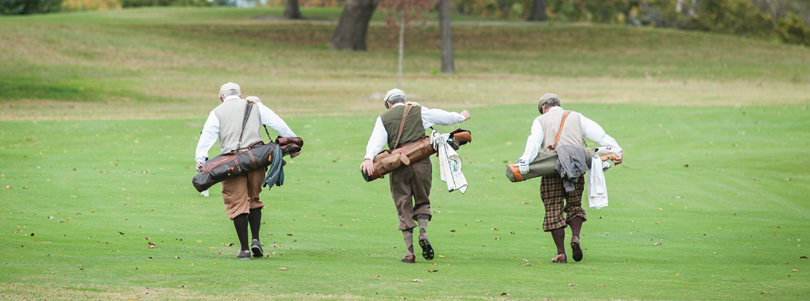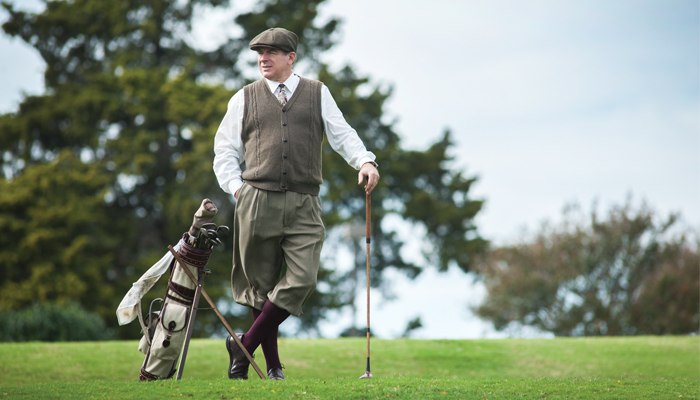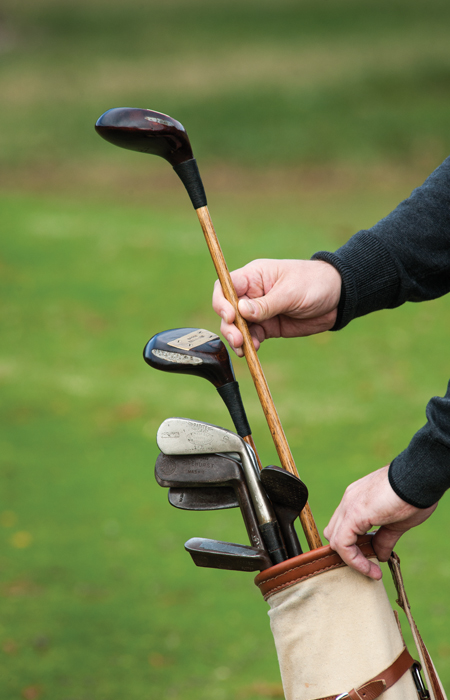The Hickory De-Evolution

Golf has never been simple to master. It’s a complex game with a multitude of moving parts. The swing is a symphony of action, starting deep within the gravitational bounds of the earth and working its way up through the legs, midsection, torso and arms to create power. As with any symphony, if any one of those components is flawed, it impacts the entire performance. Though golf is a physical activity, many would argue that what’s between the ears is far more important that anything you do externally on the golf course. This game is about perseverance, knowledge and patience. Sometimes, it seems, more patience than we are equipped to handle.
As we continue to advance technologically, clubs improve, balls are flying farther than ever, and the classic courses are constantly being updated to assure there is still a challenge waiting for the long hitting monsters that can, in modern times, overpower these venues.
For the average player, of course, this isn’t the case. The modern materials used for equipment have undoubtedly made the game more enjoyable for the thousands of players that struggle like hell to break 90. They appreciate the luxury of a 460cc driver that can add distance to their less than Dustin Johnson-esque tee shot.
That having been said, there’s very little doubt that every serious player has at least visualized what it must’ve been like to play before technology began its hostile takeover of the game. The golf nerd in all of us deserves to know just how tremendous the ball striking needed to be using clubs from the early 20th century. Clubs that weren’t referred to by a number. They weren’t the 9-iron or the 3-wood. This was back when clubs had their own personalities. They had names. Names like “mashie” or “niblick” or “spoon.” Now, first reaction might be to think these clubs’ names are far more fun to say than they would ever be to actually hit. Most current players scoff at the thought of swinging a persimmon wood from 30 years ago, much less one of its hickory shafted ancestors.
I say “most” because there is a group of players that gladly shelf today’s modern technology to test their game in this unique way. There is a growing faction of players that are putting away the modern apparatus for the classics – the Society of Hickory Golfers.

The history behind the Society of Hickory Golfers begins all the way back in 1970 when the Golf Collector’s Society formed to help preserve antique equipment. In the almost 30 years that followed, members would meet annually to trade and sell old clubs, and eventually that led to collectors wanting to see these old clubs in action. As the desire to play these clubs grew, so did the interest in hickory golf. In the mid-1990s, there were only about 15 hickory players in the United States, and once a year they would play a round at their get-together.
Fast forward to 1999 when a rules controversy brought several of the founders together, and it became evident that if these hickory rounds were to continue, some ground rules needed to be established. Thus, the Society was founded. Think of the SoHG as the USGA. They established the rules and regulations for which tournaments are conducted throughout the country. They only oversee a couple of tournaments a year, one of those being the United States Hickory Open, which takes place annually in North Carolina. The other is a Ryder Cup style event named for the late Lionel Freedman, founder of the World Hickory Open.
The DFW group didn’t get its start until 2006. It’s non-formal, there aren’t any dues, it is very much a show up when you can approach. Scott Pilgrim, who is a high school counselor by day, keeps the local email list updated and helps organize outings at least once a month, but the outings can vary depending on when players can/want to get together. Pilgrim formats the emails as a kind of newsletter, often including information on other upcoming hickory tournaments at the state and national level, mentioning websites that might be running specials on hickory equipment or clothing, and even posting links to historical facts or videos about certain venues the group may be preparing to play. As of the date of this publication, the local list has 156 members, and Pilgrim said it continues to grow on a weekly basis.
“You’re going to love this. The comradery, the pageantry, the way we dress. It’s all part of the experience. It brings us closer together, it brings us closer to the game we all love,” Pilgrim said as he passed me my snazzy pair of knickers and set of original 1930s-era clubs in the parking lot.
After a quick change, I rolled the ends of my new knickers over my long argyle socks and approached the clubhouse to Cedar Crest Golf Course in south Dallas. Cedar Crest has been around the block a time or ten, once hosting the 1927 PGA Championship won by the legendary Walter Hagen. So, it seemed appropriate that my first adventure into the hickory game would take place at a venue where one of the all-time greats once persevered and claimed a major title. As I entered the double doors, I could immediately tell this wasn’t going to be like any other round I had ever played. These gentlemen were dressed to the nines, argyle everywhere. I felt I had stumbled into a time machine and been transported back to 1925. I almost immediately understood why this is such a great way to consume the game, and I had yet to wrap my hands around a club.
After just a few swings on the range, I knew things wouldn’t be easy. To be honest, they wouldn’t have been easy regardless, as we chose a day to play where the winds were gusting to the mid-40 mph range. Although, there is something to be said for playing with low expectations. Going into the round, I understood that playing this way would be a challenge, that the clubs would likely be temperamental.
In fact, Pilgrim made a very apropos comparison as we made our way to the first tee box.
“This will be like a first date with a new woman,” Pilgrim said as he grinned. “You don’t know much about what she likes and doesn’t like, so you’ve got to feel her out before you can really commit, but you’ll have fun doing it.”
 As Pilgrim introduced me to the other players in our group, he repeatedly pointed in my direction and said, “It’s his first date.”
As Pilgrim introduced me to the other players in our group, he repeatedly pointed in my direction and said, “It’s his first date.”
I really didn’t know what to expect as far as club performance, and all I knew is that it would be vastly different. And it was. Different to say the least. The hickory shafts have more flex than modern steel shafts, which has a tremendous impact on the way certain clubs react to higher swing speeds. The driver and “spoon” (3-wood) were most noticeable because of the weight of the club head. It became apparent after a few tee shots that to successfully execute off the tee, I’d need better timing in my swing. That, coupled with the smaller club head made it very tough.
The irons, to my surprise, weren’t as difficult to hit. Now, a good bit of my success hitting them may have been a result of knowing there would be limitations and not overswinging (something we could all benefit from, even with modern equipment). I knew I would have to maintain balance, and not really rip at the ball if I were to hit the irons with any consistency. Despite a couple dead shanks, which will happen when you’re hacking a butter knife on the end of a stick, I think I was fairly efficient. In fact, I was on the green in regulation on all the par 3s, which is something I can rarely say for a round using the Titleist AP2’s I bought in 2016.
Gary Krupkin, a local attorney and business executive, who joined us in our foursome, used his collection of hickory shaft clubs as a thoroughfare to the world of competitive hickory rounds. Krupkin enjoys playing, but admitted he truly appreciates the connection hickory golf gives him to the past.
“There’s something intimate about playing with the hickory clubs,” Krupkin said. “It makes you feel closer to the game. One of the considerable pleasures of the hickory game is meeting diverse individuals with a deep and abiding sense of golf history.”
Krupkin also confessed during our round, that he’s played more rounds over recent months with his hickory set than he has with his modern clubs.
The players do use modern golf balls, which, to be honest, is a huge help. They give you maximum distance out of your mishits, which is a blessing in disguise with these wrenches. Although, there are reproduction golf balls you can get your hands on that do react like the ones that were used during that time. There are even tournaments where reproduction balls are used, and modern tees are thrown out the window for a bucket of sand on the tee box to accurately recreate what players used to do instead of teeing the ball up. In those days, players would take a small handful of sand and pile a small mound to place their ball atop of. Wild stuff, but again, all part of the experience.
There are several ways to go about acquiring the necessary equipment to play in these hickory events. Despite what you might think, a lot of the original hickory clubs from that era survived and still exist today. Collectors have slowly snapped them up from garage sales, and, with the internet, many find their way to eBay or other online auction sites. Pilgrim estimates some 75 to 80 percent of all clubs from the ‘20s and ‘30s are still in circulation or at least stashed in grandad’s garage. Once located, all they need is a little TLC, and they’re almost as good as new.
“Thousands of clubs were made after World War I,” Pilgrim said. “The United States had an infatuation with golf after Francis Ouimet won the U.S. Open in 1913, but all the raw materials were going to the war effort. Once the war was over, there was really a boom in club making, and golf took off.”
Now, if you can’t get your hands on an original set, you can pick up reproduction clubs from a couple of American retailers. Louisville Golf and Tad Moore Golf Designs both manufacture gorgeous reproduction sets that are the closest thing you can find to the real McCoy. Even if you aren’t interested in ever buying or playing a single hole with hickory clubs, you should check out these websites just to admire the craftsmanship and beauty of the clubs. They are truly a sight to behold.
The hickory passion doesn’t end on this side of the Atlantic. There are hickory groups abroad as well. Canada, Switzerland, the Czech Republic, France, Great Britain and Scotland all have their contingent. In fact, the Freedman Cup pits American and European teams against one another, and, just as the Ryder Cup, is contested every two years and alternates between stateside and across the pond.
Joe Hollerbach, another local competitor, has played in hickory tournaments on both sides of the ocean, including the Freedman. He said he’s fallen in love with the hickory game, and thinks he has an idea why people are embracing golf as it was played almost 100 years ago.

“There is something that is enticing people to come play traditional golf, and it’s hard for me to tell you exactly what it is that brings people to hickory golf, but one thing I can tell you, is people are getting bored with the modern game, and they’re actually gravitating backwards,” Hollerbach said. “People want a more traditional, more challenging game of golf. One where they’re not standing on a course that’s 7,500 yards and if you can’t hit it 300 yards, you’re going to shoot a hundred”.
The hickory shaft world is growing all the time, and for good reason. It’s somewhat of a golf awakening. An almost religious experience. If you’re a golf purist or history buff, you owe it to yourself to try this. Even if it’s just once. Most golfers I know play not for the status, or the comradery, but for the challenge. Those other things are all bi-products. Golf is difficult. It’s humbling. It can break you down and make you feeble. On the other hand, it can build you up and make you feel invincible, and it can literally happen from shot to shot. For most, that’s what makes golf great.
Playing this equipment adds another dimension to the challenge, and another layer of depth to your comprehension of just how pure this game once was. Before technology, before corporate intrusion and before national television audiences. Today, golf belongs in the mainstream. The personalities are larger than life, and the skill they display is awe inspiring. Watching today’s professionals must be consumed, because it helps us all understand just where we are on the food chain, but there is just something about experiencing golf on a spiritual level. The Society of Hickory Golfers gives all players a chance to do just that. For that one reason, it’s worth it. Get the mashie ready, because once you’ve done it, you’ll never look at this game the same way again.



